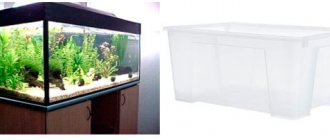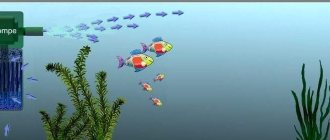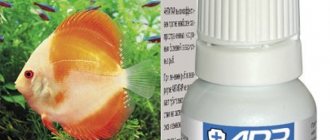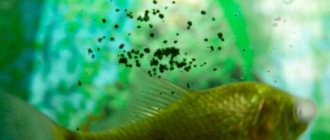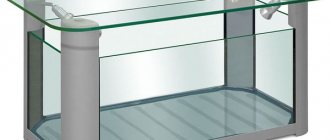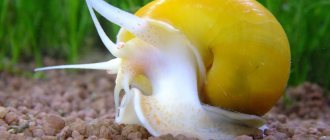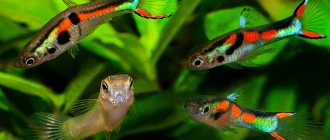Purpose of stones for an aquarium
Most aquarium fish require a variety of living conditions, so for some inhabitants of the aquarium, stones do not play any role - they only act as decoration, while for others, decorating their home with stones and minerals is vital.
What are the stones for?
- To saturate water with microelements;
- Changes in water acidity and hardness;
- Creating natural conditions suitable for reproduction and growth;
- Creating suitable conditions for plant life;
- Providing shelter for the fry.
Necessary requirements for materials
A comfortable shelter for aquatic inhabitants can be made from various materials :
- stones;
- plastic;
- glass;
- tree;
- ceramics.
At the same time, if you decide to make the decoration yourself, then you should adhere to a number of important rules, the first of which says: do no harm. This means that the raw materials should not be hazardous to either aquatic life or plants.
Basically, when selecting material, follow these principles:
- The stones should not contain lime. This substance increases the degree of acidity and reduces water quality.
- Do not take materials with a high concentration of iron. Excess of this element stimulates the growth of green algae.
- Stones from production areas and quarries are absolutely not suitable for a home pond.
- Details of decorations should not injure aquatic inhabitants. Do not use materials with sharp corners or edges.
- Wooden products must be selected carefully. Many types of wood can release harmful substances into the water. For example, oak and trees with a high concentration of resins are not recommended.
Where to get stones
The easiest way to purchase stones is to go to a pet store and buy minerals there. This is not only quick and easy, but also safe as there is little risk of getting a toxic or unsuitable breed for your aquarium. However, such pebbles, as a rule, are already processed and prepared for being in the tank, and therefore are relatively expensive. For this reason, aquarists often try to find stones on their own.
There are many options for finding stones for an aquarium, for example, on the street, in the forest, near a river or the sea. However, before you rush to pick up every stone, it is worth knowing which stones to choose. After all, if the “wrong”, in other words, harmful stone gets into the aquarium, the result of such proximity to fish can be disastrous.
Preparing for the dive
Having made your choice, you need to prepare the pebble for immersion in the aquarium. Cleaning is carried out as follows:
- Selected specimens are washed under running water and rubbed with a stiff brush, removing dirt.
- The washed stones are left to dry. After drying, acid or vinegar is dripped onto the pebble to check the reaction. If multi-colored spots or bubbles appear on the specimen, it cannot be used.
- If there is no reaction to the acid, the selected specimen is washed again and boiled for 30 minutes.
- After calcination, the material is cooled and placed in a tank.
How to choose stones for an aquarium and which ones are better?
Thus, finding the location of various stones is not enough; it is important to know the rules for choosing them. The biggest danger of choosing stones of the wrong type is a change in the water parameters in the aquarium. As a rule, the hardness and pH levels change - these parameters play a huge role, because the correct indicators ensure the normal growth of underwater plants and the well-being of fish.
In order to make sure that the selected stone will not change the chemical composition of the water in the aquarium, just drop a drop of vinegar on it. If a chemical reaction begins on its surface, this indicates that excess and harmful substances will be released into the water, which means it is not suitable for being in an aquarium.
It is best for inexperienced aquarists to give preference to quartz, which can be easily recognized by its veins and crystals that have a transparent or snow-white structure. For people who are not chasing unique aquarium decor, pebbles and shell rocks are perfect.
In general, you should choose stones depending on their purpose:
- Required as a soil topping for planting underwater plants. In this case, it is worth selecting stones measuring 5-15 mm.
- For decorating an aquarium and creating natural survival conditions. The stones should not be heavy, have a wide base, and reach a height of at least 15 cm.
- To increase water hardness levels. For such purposes, white sandstone, some types of tuff, shale, fossils, marble, dolomite, limestone and shell rock, and Kenyan stone are perfect.
- To reduce the acidity level of water. You can use limestone, calcareous tuff, white sandstone.
- Needed as aquarium decor. Frozen lava, colored stones, granite, luminous stones, and gneiss are perfect as decorative stones.
Popular decoration elements
A wide variety of aquarium design elements opens up a lot of possibilities for you, because you can use any material that suits your ideas and taste.
When choosing suitable decoration items, you need to know that in most cases they perform not only a decorative role, but also have a specific function.
Stones
Using rocks in an aquarium is a fairly popular design option. They come in several types - rock metamorphic, sedimentary and volcanic.
Mountain metamorphic stones include:
- Gneiss is a striped stone suitable for almost all design options.
- Slate. As a rule, it has a dark color. When choosing, you need to pay attention to the shape to prevent damage to the fish from sharp edges.
- Marble. It has a looser structure, so it is suitable for those cases where the germination of the soil by small algae is implied.
- Quartzite is a good solution for fans of green spaces in the aquarium. The stone itself is of different shades - from white to reddish.
Sedimentary stones include sandstone (the composition is important here, because some types can increase water hardness) and limestone (it also significantly increases hardness). Volcanic stones include granite - this is a universal option used in decoration.
driftwood
When setting up an aquarium, driftwood is often used and this is explained not only by their attractive appearance. First of all, driftwood is a natural shelter for small fish. Sometimes they can become a place for spawning or an additional source of food. Another important point is that the tree maintains an acidic environment, which is very important for vegetation and some families of fish.
Driftwood looks great in an aquarium space. They are organically overgrown with moss, so they are suitable for most styles and trends.
When choosing driftwood, you need to pay attention to the type of wood. Maple, mango, willow, beech, alder and mopani roots work best. Oak is not entirely suitable, because it produces special substances that can color the water. It is clear that driftwood should not be rotten or rotten.
The selected material must first be prepared before decorating the aquarium with it:
- We get rid of bark and loose areas.
- We destroy harmful microorganisms through heat treatment. The driftwood is placed in salted boiling water.
- Rinse and let cool.
Java moss
Java moss is one of the most striking representatives of unpretentious aquarium plants. It received its name from the island from which it was brought - Java. Outwardly, it resembles a fluffy and soft bush, formed by the interweaving of small carved leaves and thin stems. Its peculiarity is that this moss is essentially a floating plant, i.e. it does not have a root system in the usual sense. It is attached using thin threads (rhiziods) located at the ends of the stem.
Carbon dioxide is important for normal growth. It is not demanding on the level of lighting - at a high level its structure becomes denser, and at a low level the moss becomes lighter and elongated.
Priming
This is an important part of decoration, because it is the base that acts as a substrate for plants. It also filters water, absorbing the smallest particles of pollution.
There are three types of soil:
- Artificial.
- Crushed stone, sand and other natural materials.
- Soil obtained in the process of processing natural elements.
The color depends on the chosen aquarium style. It is better to choose rounded soil granules, the size of which ranges from 0.2 to 0.8 mm.
Background
The background is one of the most important parts when decorating. If you choose it correctly, you can achieve the effect of expanding the space. Also, the correct background completes the overall composition.
The background is used:
- Self-adhesive film with a corresponding pattern.
- A living background of plants attached to a grid.
- Volumetric background. Decorative elements are made from improvised materials, but it is important that all materials are non-toxic.
How to prepare stones at home
How to prepare stones at home? To do this, you will need to follow several rules:
- Inspect the stones, and then sort through them to remove excess debris in the form of earth, blades of grass, and dust. Everything should be cleaned well - this is done in order not to introduce various infections into the aquarium.
- Rinse the pebbles - use regular warm water for this. However, before rinsing them properly, they should first be soaked to dissolve all the salts. To quickly remove all dirt, you can use pumps that create a kind of flow. Thanks to this device, all dirt or its remains are removed from the stones.
Well, the fish
Actually, these inhabitants will become the main asset and decoration of a home glass pond. It is necessary to make their life in captivity as comfortable and convenient as possible.
To do this, you need to follow many rules and use additional equipment for cleaning, filtering and aerating water. But this is a topic for a separate article, because there is so much information and it needs to be digested before you decide whether or not you want to admire the beautiful spectacle of the graceful dance of veiltails or make wishes while looking at goldfish.
How to boil
How to clean stones in such a way as to destroy all infection? Boil them. In water heated to 80-85°, salt dissolves much more actively, plus all germs and microorganisms are destroyed. To ensure additional disinfection, all pebbles are dried by placing them on a clean surface so that they are exposed to sunlight.
But how long should you boil the stones? 3-4 minutes is enough. To enhance the effect, all pebbles are divided into 2-3 parts - this improves the boiling effect.
If sea stones were chosen, how long should you boil them? There is no difference between river, sea or lake rocks. The whole point is in soaking: so, if ordinary granite was soaked only once and then boiled, then this cannot be done with sea stones. They should be soaked up to four to five times due to their high salt content. The first time you should leave the stones to soak for the whole night, and then you need to change the water throughout the day. And only in the evening they can be boiled and then dried.
Thus, by properly boiling the stones, it will be possible to prevent:
- Blooms, pollution and turbidity of water;
- The occurrence of diseases and, as a result, death of fish;
- An unpleasant odor emanating from the aquarium.
How to make aquarium decor with your own hands
Background
Coconut house
Mysterious landscape
Stones
Making aquarium decor with your own hands does not require any special skills, and the simplest material is stone. You can build a beautiful grotto, slide or cave - use aquarium silicone to hold the smooth pebbles together.
Like wooden driftwood, stones need careful processing and boiling (about ten minutes). The decorations must be not only original, but also safe. Be sure to test your rocks for alkali to prevent altering the chemical balance of the water.
Apply a few drops of vinegar to the surface and observe the reaction. The appearance of hissing bubbles means that limestone is present in the composition, and it is better not to use such stone to decorate the aquarium.
Artificial elements
fb.ru>
How to properly process
It is worth treating stones using chemical solutions in cases where, for some reason, thermal treatment is impossible. Even though cleaning with special solutions is not as effective as boiling, it still copes with most harmful bacteria.
So, how to properly clean and treat stones? To do this, you need a durable but capacious container (volume is important here, since the liquid composition must cover the stones completely). Each product has its own instructions for use, so in order to properly clean the stones, you just need to follow the instructions on the package. When the stones have been in the disinfectant for a day, they need to be carefully and carefully removed, and then washed thoroughly under running water.
Testing
A good planning method involves testing the landscaping materials of the aquarium. Prepare a place where you can place rocks and driftwood , and then test different combinations, preferably on the layer of substrate you intend to use in the aquarium. Conducting the tests outside the aquarium means you can freely move objects in any direction without the risk of scratching the glass, which often happens in confined spaces inside the aquarium. Once the landscape architecture objects are in the right places, step back and look at the layout with an artist's eye. Ask yourself: are all the elements of the composition moving correctly? Is there enough negative (open) space? Where are the focal points? Do the stones match each other in their structure? Does the flow of water match the angle of the decor? Make sure each item has a purpose and complements the item next to it.
In this Iwagumi styled outdoor aquarium, it is advisable to replace the filter tubes with stylish glass ones to enhance the display. (Photo by Chris Penny)
Forget your plan
Once you've done your testing and the materials are ready to go, it's time for the final fittings: filters, CO2 system and lighting. All driftwood must sit in water for several days before it can be used in a water tank. All stones must be washed from dust. When you are finally ready to start implementing your plans, let everything take its course, forgetting about everything you had planned before, trust your instincts, and give free rein to your creativity. Your careful planning has taught you to avoid simple mistakes and outlined a rough plan for further work, but without spontaneous inspiration and intuition it is impossible to create an aquascape that you can then call your creation.
( To be )
Reference: Peter Hiscock – “Aquascaping: Style, Technique, Material” – “Tropical Habitat” Publication
Basic design options for stone compositions
Not everyone, even an experienced aquarist, let alone beginners, knows how to decorate an aquarium with fish with a stone composition. After all, the design of the tank should be unobtrusive, beautiful and stylistically correct. But for this it is not at all necessary to invent something masterly and unique on your own; you can create a composition in one of the styles that are popular at the present time.
- Decoration in Dutch style. It resembles a full-fledged flowerbed with green, red and other plants, only located under water. In such an aquarium there are many green plants, but they are all sorted by size, color and height, have their own clearly defined place, and therefore do not creep into “foreign” territory. In this case, the role of pebbles, namely pebbles and shell rock, will be to imitate paths between flower beds.
- Stone composition in Japanese style. Here, too, there is an imitation of terrestrial living vegetation, but of a different kind. In this style, the stones will not be used as a substrate, but as iwagumi - a typical stone composition of Japanese gardens. In this case, excessive decorations are not appropriate, since minimalism is welcomed in the design. In order to achieve picturesqueness, cobblestones are selected in different sizes.
- Decorating an aquarium with stones in a pseudo-natural style. An excellent option for those people who do not want to spend a lot of effort on decorating both a large and small aquarium. This style is characterized by a minimum of effort and money costs, and therefore has a fairly simple appearance. Granite, shell rock and pebbles will fit well into such an atmosphere.
- Decorating an aquarium in a natural style. This style is rightfully considered one of the most difficult to reproduce, so only experienced aquarists resort to it. The purpose of this design is to recreate as accurately as possible a certain section of the bottom of the reservoir in the aquarium.
Features of aquarium design
Now there is no problem ordering the production of an aquarium of the shape or size you need, which would be suitable for a specific room. The small size and round shape significantly complicate decoration, so it needs to be thought through thoroughly. The shape also influences the choice of inhabitants - microrasboras, catfish, guppies and other fish are suitable.
The thickness of the soil should be approximately 5 centimeters. Installation of a filtration system and compressor is required. Many people use the installation of a false bottom as an alternative to the usual soil.
If you have ordered a corner aquarium, then you need to take care of purchasing furniture in advance - most often these models are placed on a cabinet of the appropriate size. At the same time, their designs must be made in accordance with the general concept.
Dimensions play an important role in decoration. Many people believe that a minimalist design in a large aquarium is not quite the right solution. This stereotype. The same “rock garden” will look organic, because it implies the presence of a large free space.
If you have chosen a “live” design for a small aquarium, then it is better to choose slow-growing plants. But they also require timely pruning.
The back volumetric background can be made using ordinary polystyrene foam. They can be used to depict stones and relief rocks. Its surface can be smoothed by conventional firing. Next, the workpiece is treated with cement, sprinkled with sand and painted. All this is secured with sealant.
There are various design options for aquariums, but some of them are quite difficult to implement. If you want to save time and effort, order the production and decoration of an aquarium from. See examples of our work on the website.
Daily care
The owner of the fish needs to devote 15-20 minutes of time to the inhabitants of the miniature pond every day.
The list of mandatory manipulations includes:
- Checking the tightness of the walls and the serviceability of the installed equipment. Examine the glass for cracks and drips. Make sure that the backlight is working and air is flowing into the water from the aerator. The thermometer should show the correct temperature, and the temperature difference between the water near the surface and the ground should not exceed 3 degrees.
- Inspect the tank for the presence of algae, signs of water blooms or cloudiness.
- Feeding. Daily, 1-2 times a day at a set time. Fish are prone to overeating, which can lead to their death, so monitor the activity with which they eat food.
- Inspection of freshwater inhabitants. It is produced during feeding, since at this time most of the inhabitants of the underwater world swim out of their shelters in search of food. Healthy fish are active and mobile, they do not sway or squeeze their fins. There should be no spots, rashes or sores on the body. Count your pets. If someone has died, fish out the corpse and find out the cause of death.
- Removing food residues. 20 minutes after feeding, make sure that there is no food residue left on the surface of the soil. Excess can clog the water and filter and must be removed with a siphon.
